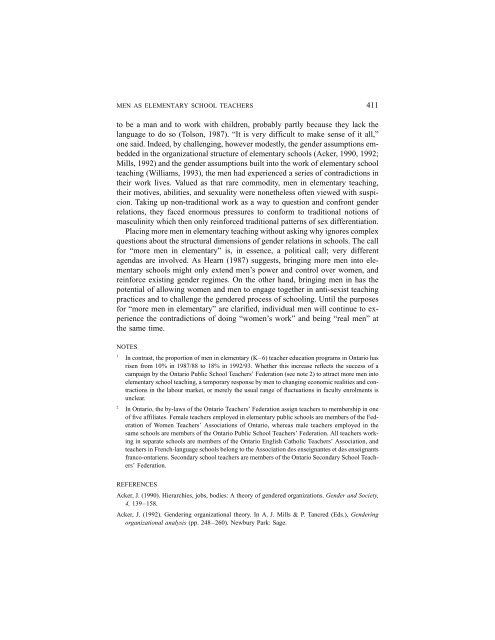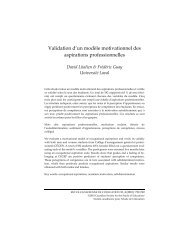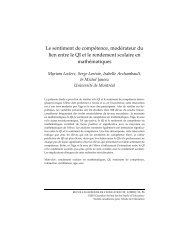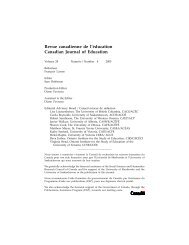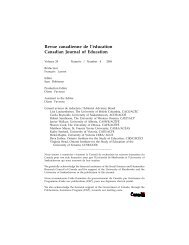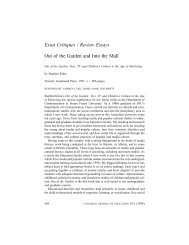Mireille Falardeau et Michel Loranger Le choix de stratégies ... - CSSE
Mireille Falardeau et Michel Loranger Le choix de stratégies ... - CSSE
Mireille Falardeau et Michel Loranger Le choix de stratégies ... - CSSE
You also want an ePaper? Increase the reach of your titles
YUMPU automatically turns print PDFs into web optimized ePapers that Google loves.
MEN AS ELEMENTARY SCHOOL TEACHERS 411<br />
to be a man and to work with children, probably partly because they lack the<br />
language to do so (Tolson, 1987). “It is very difficult to make sense of it all,”<br />
one said. In<strong>de</strong>ed, by challenging, however mo<strong>de</strong>stly, the gen<strong>de</strong>r assumptions embed<strong>de</strong>d<br />
in the organizational structure of elementary schools (Acker, 1990, 1992;<br />
Mills, 1992) and the gen<strong>de</strong>r assumptions built into the work of elementary school<br />
teaching (Williams, 1993), the men had experienced a series of contradictions in<br />
their work lives. Valued as that rare commodity, men in elementary teaching,<br />
their motives, abilities, and sexuality were non<strong>et</strong>heless often viewed with suspicion.<br />
Taking up non-traditional work as a way to question and confront gen<strong>de</strong>r<br />
relations, they faced enormous pressures to conform to traditional notions of<br />
masculinity which then only reinforced traditional patterns of sex differentiation.<br />
Placing more men in elementary teaching without asking why ignores complex<br />
questions about the structural dimensions of gen<strong>de</strong>r relations in schools. The call<br />
for “more men in elementary” is, in essence, a political call; very different<br />
agendas are involved. As Hearn (1987) suggests, bringing more men into elementary<br />
schools might only extend men’s power and control over women, and<br />
reinforce existing gen<strong>de</strong>r regimes. On the other hand, bringing men in has the<br />
potential of allowing women and men to engage tog<strong>et</strong>her in anti-sexist teaching<br />
practices and to challenge the gen<strong>de</strong>red process of schooling. Until the purposes<br />
for “more men in elementary” are clarified, individual men will continue to experience<br />
the contradictions of doing “women’s work” and being “real men” at<br />
the same time.<br />
NOTES<br />
1<br />
In contrast, the proportion of men in elementary (K–6) teacher education programs in Ontario has<br />
risen from 10% in 1987/88 to 18% in 1992/93. Wh<strong>et</strong>her this increase reflects the success of a<br />
campaign by the Ontario Public School Teachers’ Fe<strong>de</strong>ration (see note 2) to attract more men into<br />
elementary school teaching, a temporary response by men to changing economic realities and contractions<br />
in the labour mark<strong>et</strong>, or merely the usual range of fluctuations in faculty enrolments is<br />
unclear.<br />
2<br />
In Ontario, the by-laws of the Ontario Teachers’ Fe<strong>de</strong>ration assign teachers to membership in one<br />
of five affiliates. Female teachers employed in elementary public schools are members of the Fe<strong>de</strong>ration<br />
of Women Teachers’ Associations of Ontario, whereas male teachers employed in the<br />
same schools are members of the Ontario Public School Teachers’ Fe<strong>de</strong>ration. All teachers working<br />
in separate schools are members of the Ontario English Catholic Teachers’ Association, and<br />
teachers in French-language schools belong to the Association <strong>de</strong>s enseignantes <strong>et</strong> <strong>de</strong>s enseignants<br />
franco-ontariens. Secondary school teachers are members of the Ontario Secondary School Teachers’<br />
Fe<strong>de</strong>ration.<br />
REFERENCES<br />
Acker, J. (1990). Hierarchies, jobs, bodies: A theory of gen<strong>de</strong>red organizations. Gen<strong>de</strong>r and Soci<strong>et</strong>y,<br />
4, 139–158.<br />
Acker, J. (1992). Gen<strong>de</strong>ring organizational theory. In A. J. Mills & P. Tancred (Eds.), Gen<strong>de</strong>ring<br />
organizational analysis (pp. 248–260). Newbury Park: Sage.


